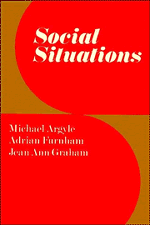Book contents
- Frontmatter
- Contents
- Preface
- 1 Introduction
- 2 The analysis of social situations
- 3 The effect of the situation on behaviour
- 4 Drives and goals
- 5 Rules
- 6 Role-systems
- 7 Repertoire of elements
- 8 Sequences of interaction
- 9 Concepts and cognitive structures
- 10 Environmental setting
- 11 Language and speech
- 12 Stressful situations
- 13 Applications of situational analysis
- 14 Conclusions
- References
- Names index
- Subject index
5 - Rules
Published online by Cambridge University Press: 01 June 2011
- Frontmatter
- Contents
- Preface
- 1 Introduction
- 2 The analysis of social situations
- 3 The effect of the situation on behaviour
- 4 Drives and goals
- 5 Rules
- 6 Role-systems
- 7 Repertoire of elements
- 8 Sequences of interaction
- 9 Concepts and cognitive structures
- 10 Environmental setting
- 11 Language and speech
- 12 Stressful situations
- 13 Applications of situational analysis
- 14 Conclusions
- References
- Names index
- Subject index
Summary
Introduction
We propose to use the concept of rules as a central explanatory device in the analysis of situations. People come together in social situations so that certain goals can be attained; rules develop to coordinate the behaviour of interactors so that these goals can be met. But what exactly is meant by a ‘rule’? By a rule we mean ‘behaviour which members of a group believe should, or should not, or may be, performed in some situation, or range of situations’. This is based on the notion of appropriateness; when a person breaks a rule he has made a mistake (Winch, 1958).
Rules in this sense can be distinguished from ‘norms’, which are often used by social psychologists to refer to modal behaviour, i.e. what most people do; sometimes most people break the rules. Rules can also be distinguished from ‘conventions’, which refer to arbitrary customs such as fashion in clothes. It is a rule in cricket that the batsman should use a bat (rather than, say, a tennis racquet), but a convention that he shall wear white trousers. Conventions are elements of shared culture which can vary without affecting task performance or attainment of goals. This distinction is investigated empirically in experiment 5.2. Some rules emerge during the life of a particular group, such as a family or a research group.
- Type
- Chapter
- Information
- Social Situations , pp. 126 - 163Publisher: Cambridge University PressPrint publication year: 1981



